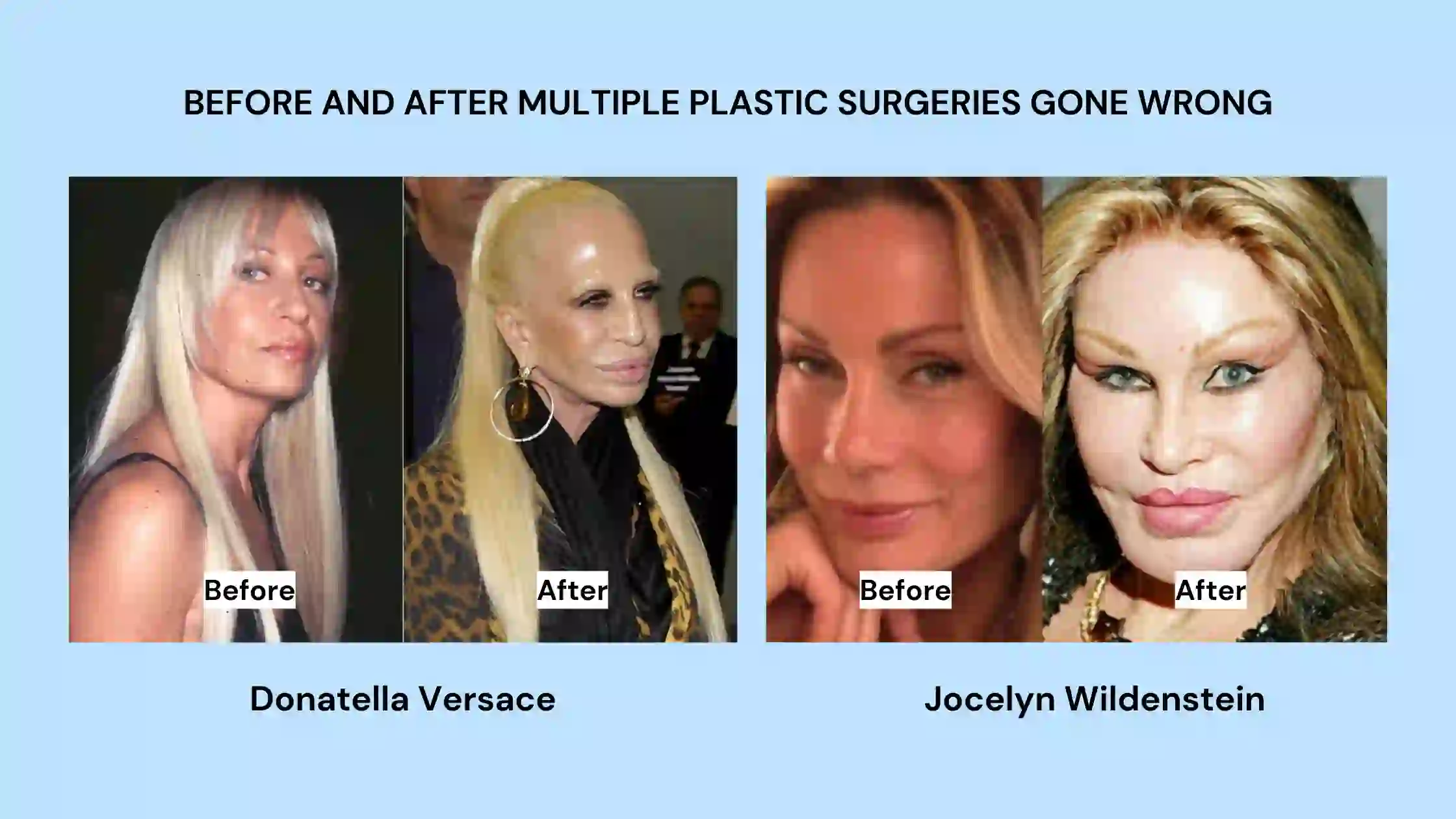What Plastic Surgeries Can Be Combined? Safety Guidelines to Achieve Optimum Results

Introduction:
While Plastic surgery can greatly enhance your looks and appearance and help boost your self-esteem; if you are being too ambitious and want too much too soon, that may not be a good idea. There are examples galore of plastic surgery gone wrong with too much plastic surgery, and celebrities like Jocelyn Wildenstein aka 'Cat Woman', Amanda Lepore, Donatella Versace, etc., are live examples. So, what determines the limit of plastic surgery, what plastic surgeries can be combined?and how much plastic surgery is too much surgery? Experts say there are thumb rules that need to be followed.
Therefore, let us delve deep into the what plastic surgeries can be combined and what cannot be combined and also what general guidelines should be followed to determine the safety of combining plastic surgery procedures; and how does one discern when the combination becomes excessive? When considering a combination of multiple plastic surgery interventions, what constitutes an excessive or unsafe threshold?
While we try to understand what plastic surgeries can be combined, let us also explore the factors to consider while combining plastic surgery procedures:
Length of surgery/ Anesthesia time - While combining multiple procedures the most important consideration is the length of surgery and how long is the patient supposed to be under anesthesia. As a rule of thumb, most srgeons are of the opinion that any elective procedure beyond 5 and a half to six hours is not advisable. Beyond this timeframe, there is a heightened risk of serious hazards like deep vein thrombosis (DVT) blood clots, a rare but potentially life-threatening complication.
Additionally, prolonged procedures often lead to lower body temperatures in patients, elevating the risks of postoperative infection, nausea, and vomiting. Furthermore, very long procedures may lead to factors like surgeon fatigue, which can impact the surgical outcome and the final results that the patient is going to achieve. General Health Condition of Patient - Young patients who do not have any co-morbid factors like Diabetes, Hypertension, or thyroid conditions are ideal candidates for combined/ multiple procedures. These patients can withstand long surgeries much better than patients above 45-50 years of age, or people with associated health conditions. In addition, smokers are at a much higher risk of developing complications after long surgeries. Smoking particularly impacts aesthetic plastic surgery procedures that involve undermining large flaps of skin like face lift, tummy tuck, breast reduction, etc. and people undergoing combined/ long surgeries are even more at risk. Procedures being combined - Many patients frequently choose to combine a medically essential procedure, such as a septoplasty for a deviated septum, with aesthetic surgeries like rhinoplasty or pair a breast reduction with liposuction. According to experts, it is a widespread practice for patients to receive more than one procedure concurrently, and in certain situations, this approach is considered highly beneficial. For instance, combining liposuction in multiple areas capitalizes on a unified anesthetic experience and recovery period, offering enhancements for multiple body regions. Similarly, during facelift procedures, addressing the eyelids concurrently is common, enabling the treatment of multiple facial areas in a single session and reducing overall downtime.
What is advisable however is not to combine procedures on significantly different areas of the body. A formidable face lift surgery which in itself is a long and labor-intensive procedure for the surgeon should not be combined with an extensive breast reduction surgery.
Similarly, Brazilian butt lift surgery which involves a combination of liposuction and butt augmentation, should sparingly be coupled up with a breast procedure as this may pose challenges during recovery since these surgeries address different areas of the body. Post-butt lift, maintaining pressure off the backside is essential, whereas for breast augmentation, lying on the back is preferred to avoid putting pressure on the breasts. Depending on which areas of the buttocks the fat has been injected, the patient may be able to lie on the sides, so these surgeries need to be planned prudently. It is thus advisable to carefully consider these factors before opting for a combination of such distinct procedures. Ambulation & Recovery after surgery: Besides the areas being treated, it is also important to consider how the procedures impact the recovery of the patient. It is highly advisable to refrain from combining procedures that could markedly affect a patient's mobility after the operation. Promoting mobility post-surgery helps mitigate certain risks of complications and expedites the healing process. Most surgeons prefer ambulating the patient on the first day of the surgery itself, which clearly indicates the significance of postoperative ambulation. Too long a surgery or too many procedures combined together may hamper the mobility of the patient, thereby compromising their safety. In addition, recovering from multiple plastic surgeries simultaneously may result in a longer and more painful recovery compared to a single procedure. Safety limit of single surgery: While multiple procedures done together are one thing, doing too much of a single surgery may also pose risks. The biggest example of this is Large Volume or Mega liposuction. Though liposuction is a safe procedure in itself, removing too much fat from a patient's body in one go has its own share of risks.The terms 'Mega Liposuction' or 'large volume liposuction', refer to extracting over 5 liters of fat/ total volume from the patient during a liposuction procedure.
As a rule of thumb, the upper limit of liposuction is usually 8 to 10 percent of body weight or five liters of fat, whichever is lesser. Exceeding this limit can jeopardize the patient's health and safety. If the surgeon foresees the necessity to eliminate more than five liters of fat, the patient can always undergo multiple Lipo procedures at specified gaps, to manage the process safely.Best Practices for Safe Multi Aesthetic Plastic Surgery Procedures

While performing a combination of procedures like Mommy makeover, body contouring, face plastic surgery, etc., the surgeons generally exercise caution and make sure the following parameters are taken care of:
Thorough Medical Evaluation - Most surgeons make sure that any patient planning to undergo multiple procedures undertakes a whole battery of tests including blood investigations, viral markers, chest x-ray/ ECG, and other tests like a 2D echo, as per the age and history of the patient. Staging of very long procedures- When the surgeries are too long and tend to cross the 5/6-hour benchmark, staging of procedures is advisable. Consideration of blood loss- Any surgeries that lead to excessive blood loss, like a tummy tuck, should be prudently combined with other procedures by taking into account the expected cumulative blood loss. Accreditation of surgical facility- Extensive/ long surgeries should be performed at accredited facilities that adhere to safety standards and are well-equipped to handle combined procedures. Recovery planning- The downtime and recovery period after combined procedures should be planned well so that the patient gets adequate time for rest and recuperation, ensuring a smooth recovery, especially in the case of overseas patients. Post-operative monitoring- Post-operative monitoring plays a crucial role in the hassle-free recovery. It is important that the patient has regular follow-ups with the surgeon to monitor recovery. Planning your multiple procedures well and following guidelines can help you achieve the best possible results while minimizing potential risks. Though plastic surgery is certainly a valuable means to enhance your looks and uplift your self-esteem, it is crucial to exercise moderation. We hope that this blog provides an answer to the generally asked question of what plastic surgeries can be combined together. If you have any more questions, you can visit the website and get all the information you require or simply reach out to IndiCure at +919320036777 or email info@indicure.com.